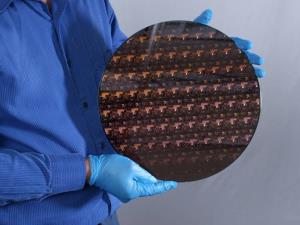



Date:07/05/21
 IBM claims it has taken a major step forward in chip technology by making the first 2nm chip. The company says it has squeezed 50 billion transistors onto a chip the size of one's fingernail.
IBM claims it has taken a major step forward in chip technology by making the first 2nm chip. The company says it has squeezed 50 billion transistors onto a chip the size of one's fingernail.
The architecture can help processor makers deliver a 45 percent performance boost with the same amount of power as current 7nm-based chips, or the same level of performance using 75 percent less energy, according to IBM. Many 2nm-based processors will likely deliver something in between, a balance of better performance and improved power efficiency.
Mobile devices with 2nm-based processors could have up to four times the battery life of ones with 7nm chipsets. IBM claims you might only need to charge those handsets every four days. Laptops would get a speed boost from such processors, while autonomous vehicles will detect and react to objects more quickly, according to IBM. The company claims the tech will benefit the likes of data center power efficiency, space exploration, artificial intelligence, 5G and 6G and quantum computing.
IBM has seemingly made the 2nm breakthrough before its competitors. Apple's M1 and A14 arrived alongside Huawei's Kirin 9000 last fall as the first processors based on TSMC's 5nm technology node process. Other manufacturers, such as AMD and Qualcomm, are typically using TSMC's 7nm chips right now, although Qualcomm's Snapdragon 888 is manufactured on Samsung's 5nm tech. As for Intel, the company is unlikely to release 7nm processors until 2023; it's currently using 10nm and 14nm chips. However, Intel's chips tend to have greater transistor density than rivals at the same nm figure, so it's not an apples-to-apples comparison. TSMC, meanwhile, is also working on a 2nm process and expects to go into volume production of 4nm and 3nm next year.
It's unclear when 2nm processors will make their way into consumer devices, but announcing 2nm chips and building them at scale are different challenges. IBM plans to release its first commercial 7nm processors this year in its Power Systems servers. Although 2nm processors are probably at least a few years away from coming to laptops and phones, it's at least good to know that more powerful and efficient CPUs are in the pipeline.
IBM says it has created the world’s first 2nm chip
 IBM claims it has taken a major step forward in chip technology by making the first 2nm chip. The company says it has squeezed 50 billion transistors onto a chip the size of one's fingernail.
IBM claims it has taken a major step forward in chip technology by making the first 2nm chip. The company says it has squeezed 50 billion transistors onto a chip the size of one's fingernail.The architecture can help processor makers deliver a 45 percent performance boost with the same amount of power as current 7nm-based chips, or the same level of performance using 75 percent less energy, according to IBM. Many 2nm-based processors will likely deliver something in between, a balance of better performance and improved power efficiency.
Mobile devices with 2nm-based processors could have up to four times the battery life of ones with 7nm chipsets. IBM claims you might only need to charge those handsets every four days. Laptops would get a speed boost from such processors, while autonomous vehicles will detect and react to objects more quickly, according to IBM. The company claims the tech will benefit the likes of data center power efficiency, space exploration, artificial intelligence, 5G and 6G and quantum computing.
IBM has seemingly made the 2nm breakthrough before its competitors. Apple's M1 and A14 arrived alongside Huawei's Kirin 9000 last fall as the first processors based on TSMC's 5nm technology node process. Other manufacturers, such as AMD and Qualcomm, are typically using TSMC's 7nm chips right now, although Qualcomm's Snapdragon 888 is manufactured on Samsung's 5nm tech. As for Intel, the company is unlikely to release 7nm processors until 2023; it's currently using 10nm and 14nm chips. However, Intel's chips tend to have greater transistor density than rivals at the same nm figure, so it's not an apples-to-apples comparison. TSMC, meanwhile, is also working on a 2nm process and expects to go into volume production of 4nm and 3nm next year.
It's unclear when 2nm processors will make their way into consumer devices, but announcing 2nm chips and building them at scale are different challenges. IBM plans to release its first commercial 7nm processors this year in its Power Systems servers. Although 2nm processors are probably at least a few years away from coming to laptops and phones, it's at least good to know that more powerful and efficient CPUs are in the pipeline.
Views: 788
©ictnews.az. All rights reserved.Similar news
- Azerbaijani project to monitor disease via mobile phones
- Innovative educational system to be improved under presidential decree
- NTRC prolongs license of two TV and radio organizations for 6 years
- Azerbaijan establishes e-registry for medicines
- Azerbaijani museum introduces e-guide
- Nar Mobile opens “Nar Dunyasi” sales and service center in Siyazan city
- International conference on custom electronic services held in Baku
- OIC secretary general to attend COMSTECH meeting in Baku
- Azerbaijan develops earthquake warning system
- New law to regulate transition to digital broadcasting in Azerbaijan
- Azerbaijani State Social Protection Fund introduces electronic digital signature
- Intellectual traffic management system in Baku to be commissioned in December
- Tax Ministry of Azerbaijan started receiving video-addresses
- World Bank recommends Azerbaijan to speed up e-service introduction in real estate
- Azerbaijan to shift to electronic registration of real estate





















